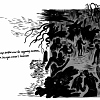Snow White: A grim fairy tale

Princess Snow White of Disney's Snow White and the Seven Dwarfs is undoubtedly one of the most popular Disney princesses till date. Ever since the release of the movie, Snow White has been the icon of classic Disney princesses. Her story, illustrating the journey towards finding true love and friendship, captured everyone's hearts. However, fun fact: Snow White originally had no element of love at all. The story was more concerned with exploring negative human traits and the opposing themes of vanity and kindness.
Before The Brothers Grimm published their version of the story, titled Sneewittchen, the original Italian folktale was about a mother's envy and jealousy towards her own daughter. This was later changed by the Grimm brothers as they held motherhood sacred. The essence of the 1812 version is similar to that of Disney's Snow White except for a few elements, such as cannibalism, paedophilia, domestic gender roles, and more. Differences in those elements change the narrative from what we know to be a love story, to something disturbingly dark. Disney decided to turn a blind eye to the societal issues in the original story by hiding them behind the rose-coloured world of love, and by introducing the "true love's kiss" trope (if anything, the kiss is a non-consensual act rather than an act of love). Regardless of how messed up the trope is, it has thrived for years and is still accepted widely.
Originally, in the Grimm brothers' version, Snow White is introduced as a seven-year-old child. Although really young, she was still greatly envied by her stepmother, so much so that the stepmother did not hesitate to have the child killed. Not knowing that what the huntsman had brought back was a wild boar's heart, and assuming that it belonged to Snow White, it was salted and cooked to be devoured by her stepmother, the Ǫueen. Pretty grotesque for a children's fairy tale.
Unlike the cartoon, the Ǫueen in the 1812 version attempts to kill her not once, but three times, each time using a different method. Firstly, by tying her with lace so tightly that it "[takes] Snow-white's breath away"; secondly, using a poisoned comb; and lastly, with a beautiful red poisoned apple. While the lace was cut and the comb was removed to bring Snow White back to life, there was no way to take out the already eaten piece of apple. And so, she was pronounced dead. The main plot of the cartoon, however, was set around the poisoned apple and how the curse could be broken by a "true love's kiss".
At this point in the story, the Prince is introduced for the first time. Seeing the ever so beautiful Snow White, he wishes to take the coffin in exchange for whatever is asked of him. Although his offer is declined, the dwarfs eventually agree to hand over the coffin to him. On the way back, as they stumble over a bush, the piece of poisoned apple comes out of Snow White's throat—and just like that, she is alive and well once more.
The Prince proposes to Snow White, and their wedding is held with grandeur. It is important to recall here that Snow White was a seven-year-old child at the beginning of the story. Because of the unspecified period of her poisoned slumber, it is difficult to ascertain her age at the time of wedding. Regardless, it is certain that she is definitely still a minor and too young for the Prince to marry.
The Grimm Brothers' Sneewittchen covers many sensitive issues that we have just started to speak out about in the 21st century. Disney had to sanitize the grim story to make it child-friendly and please the then society of 1937. Disney sold dreams, and the idea of a "true love's kiss" is an essential part of that made up dream. For the children of our day and age, it is important for this part of the story to be changed so that a more distinguished and appropriate message is sent. The act of non consensual kiss in the disguise of a true love's kiss is no longer acceptable, and children need to be taught the importance of consent. However, whether it is the year 1937 or 2023, themes of vanity, jealousy, and kindness remain relevant in every timeline.
Jabin Tasmin Shatabdi is a student of Linguistics at North South University.

 For all latest news, follow The Daily Star's Google News channel.
For all latest news, follow The Daily Star's Google News channel. 











Comments